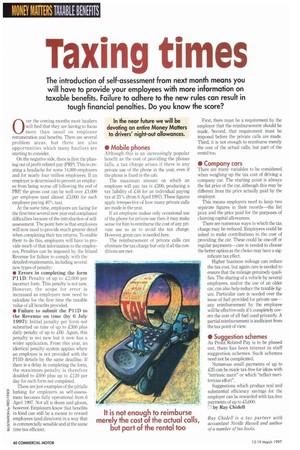Taxing times
Page 52

If you've noticed an error in this article please click here to report it so we can fix it.
The introduction of self-assessment from next month means you will have to provide your employees with more information on taxable benefits. Failure to adhere to the new rules can result in tough financial penalties. Do you know the score?
In the near future we will be devoting an entire Money Matters to drivers' night-out allowances. 0 ver the coming months most hauliers will find that they are having to focus more than usual on employee remuneration and benefits. There are several problem areas, but there are also opportunities which many hauliers are starting to consider.
On the negative side, there is first the phasing out of profit-related pay (PRP). This is creating a headache for some 14,000 employers and for nearly four million employees. If an employer is determined to prevent an employee from being worse off following the end of PRP, the gross cost can be well over £1,000 per employee (and almost £3,000 for each employee paying 40% tax).
At the same time, employers are facing for the first time several new year-end compliance difficulties because of the introduction of selfassessment. The point here is that employees will now need to provide much greater detail when completing their tax returns. To enable them to do this, employers will have to provide much of that information to the employees. Penalties can be imposed by the Inland Revenue for failure to comply with the detailed requirements, including several new types of penalty:
• Errors in completing the form P1 1D: Penalty of up to £3,000 per incorrect form. This penalty is not new. However, the scope for error is increased as employers now need to calculate for the first time the taxable value of all benefits provided.
• Failure to submit the P1113 to the Revenue on time (by 6 July 1997): Initial penalty per form not submitted on time of up to £300 plus daily penalty of up to £60. Again, this penalty is not new but it now has a wider application. From this year, an identical penalty system applies where an employee is not provided with the Pill) details by the same deadline. If there is a delay in completing the form, the maximum penalty is therefore doubled to £600 plus up to £120 per day for each form not completed.
These are just examples of the pitfalls lurking for employers as self-assessment becomes fully operational from 6 April 1997. Not all is doom and gloom, however. Employers know that benefits in kind can still be a means to reward employees (and directors) in a way that is commercially sensible and at the same time tax-efficient.
• Mobile phones
Although this is an increasingly popular benefit as the cost of providing the phones falls, a tax charge arises if there is any private use of the phone in the year, even if the phone is fixed in the cab.
The maximum amount on which an employee will pay tax is £200, producing a tax liability of .C46 for an individual paying tax at 23% (from 6 April 1997). These figures apply irrespective of how many private calls are made in the year.
If an employee makes only occasional use of the phone for private use then it may make sense for him to reimburse the cost of any private use so as to avoid the tax charge. However, great care is needed here.
The reimbursement of private calls can eliminate the tax charge but only if all the conditions are met. First, there must be a requirement by the employer that the reimbursement should be made. Second, that requirement must be imposed before the private calls are made. Third, it is not enough to reimburse merely the cost of the actual calls, but part of the rental mo.
• Company cars
There are many variables to be considered when weighing up the tax cost of driving a company car. The starting point is always the list price of the car, although this may be different from the price actually paid by the employer.
This means employers need to keep two separate figures in their records—the list price and the price paid for the purposes of claiming capital allowances.
There are numerous ways in which the tax charge may be reduced. Employees could be asked to make contributions to the cost of providing the car. These could be one-off or regular payments—care is needed to choose the better option as the choice may have a significant tax effect.
Higher business mileage can reduce the tax cost, but again care is needed to ensure that the mileage genuinely qualifies. The sharing of a vehicle by several employees, and/or the use of an older car, can also help reduce the taxable figure. Particular care is needed over the issue of fuel provided for private use— any reimbursement by the employee will be effective only if it completely covers the cost of all fuel used privately. A partial reimbursement is inefficient from the tax point of view.
• Suggestion schemes
As Profit Related Pay is to be phased out, there has been interest in staff suggestion schemes. Such schemes need not be complicated.
Numerous small payments of up to £2.5 can be made tax-free for ideas with "intrinsic merit" or which "reflect meritorious effort".
Suggestions which produce real and substantial efficiency savings for the employer can be rewarded with tax-free payments of up to £5,000.
El by Ray Chidell
Ray Chidell is a tax partner with accountant Neville Russell and author of a number of tax hooks.
























































































































